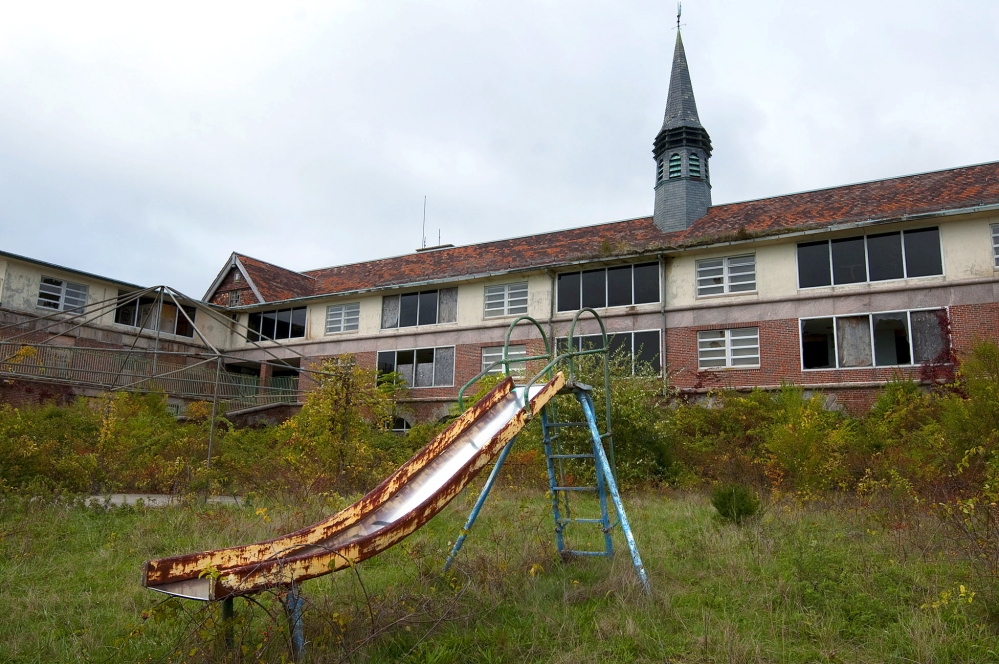WATERFORD, Conn. — The state knows the big draw of its newest park, Seaside, will be its sandy beaches and the rolling grassy lawns that look out onto Long Island Sound. But a look inland reveals what makes this 36-acre spot unique: a now-defunct sanatorium designed by noted architect Cass Gilbert for children who suffered from a special kind of tuberculosis.
While Gilbert is best known for his work in New York City, like the iconic Woolworth Building and the U.S. Customs House, residents of greater Waterbury will know his Waterbury work, too.
In 1913, he designed the Waterbury Municipal Center, a group of downtown buildings that includes the former Waterbury National Bank, the former Chase Brass Co. headquarters and Waterbury City Hall. His Waterbury work was done in his trademark monumental style. But at Seaside, some of the last work that Gilbert did, Gilbert left that look behind for the domestic appeal of Tudor Revival.
A consultant, Jan Cunningham, outlined Gilbert’s unusual choices in 1994, back when the state decided to close Seaside and sought to add it to the National Register of Historic Places. Gilbert used a primarily residential architectural style to soften the hospital setting, using decorative details and a wealth of materials not usually employed in institutions, Cunningham said. His use of gables and repetitive decorative dormers are more of a residential touch, and the central spire of the main hospital building is more decorative than anything else, Cunningham said.
“Gilbert designed Seaside to make the children feel at home and take advantage of that restorative setting,” said Susan Whalen, state Deputy Commissioner of Environmental Conservation.
At the time, the medical community believed prolonged exposure to the sun, or heliotherapy, to be the best treatment for the two strains of tuberculosis most commonly found in children. Connecticut decided to build the first institution in the country built exclusively for heliotherapy treatment of tuberculosis, and it wanted a famous architect to make a splash, Cunningham said.
Gilbert sited the main hospital building facing south for maximum sun exposure, and incorporated extensive open terraces to give each floor access to sunbathing areas, Cunningham noted. The use of antibiotics to treat tuberculosis by 1947, and to cure it when used in combination with other drugs by 1953, ended the need for sanatoriums like Seaside.
The state changed seaside into a regional center for intellectually disabled people in 1961. The inside of the hospital was remodeled to that use, leaving few Gilbert touches there. The state stopped accepting new admissions there in the 1980s, beginning the process of deinstitutionalizing the disabled, and closed the doors for good in 1996. Since then, it has stood empty.
The state tapped a private developer, Mark Steiner, to redevelop the property, but his plans to create an inn and luxury house there stalled after meeting with local opposition and zoning denials. Earlier this month, Gov. Dannel P. Malloy announced plans to add Seaside to the state park system, making it the first new coastal park since the addition of Bluff Point State Park in Groton in 1963.
It’s still too early in the planning process to know what kind of park Seaside will be, or when it will open, said Dennis Schain of the state Department of Energy and Environmental Protection. The state must evaluate the condition of the buildings, including a main hospital, a nurses’ residential building, a duplex dormitory and a superintendent’s house, as well as the beach, he said.
The buildings appear to have suffered greatly from years of sitting empty, a target of vandals and thrillseekers who claim the hospital is haunted. Windows and doors are busted. Roofs are sagging.
“It is obviously a beautiful location, perfect for passive recreation,” Schain said. “Walking the beach. Picnics. Wading, maybe swimming. But it’s far too early to know if there’s more we can do.”
Send questions/comments to the editors.




Success. Please wait for the page to reload. If the page does not reload within 5 seconds, please refresh the page.
Enter your email and password to access comments.
Hi, to comment on stories you must . This profile is in addition to your subscription and website login.
Already have a commenting profile? .
Invalid username/password.
Please check your email to confirm and complete your registration.
Only subscribers are eligible to post comments. Please subscribe or login first for digital access. Here’s why.
Use the form below to reset your password. When you've submitted your account email, we will send an email with a reset code.